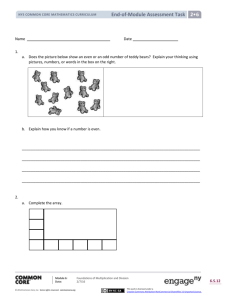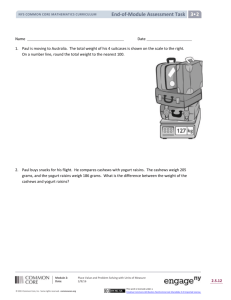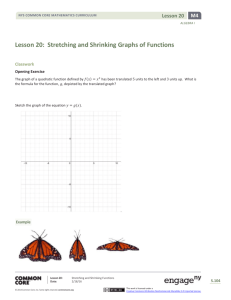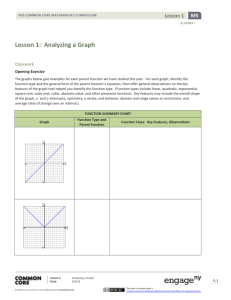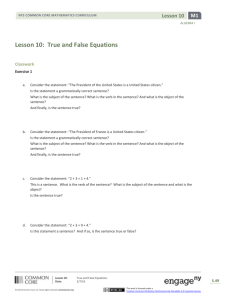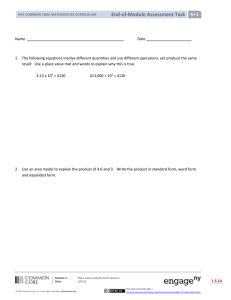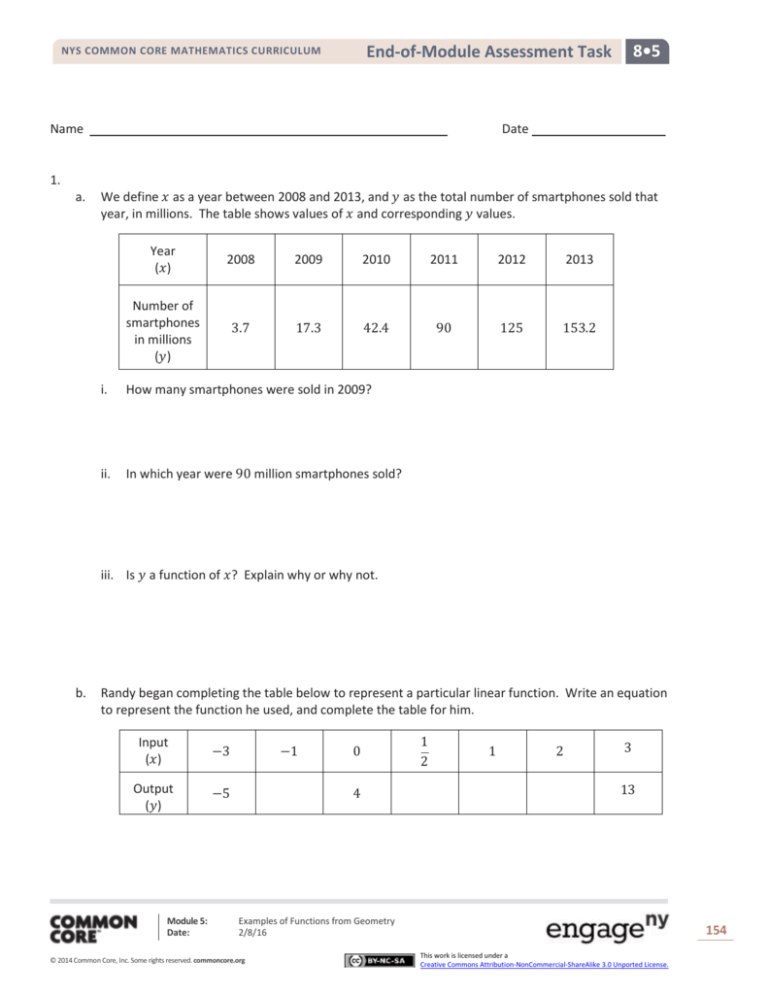
8•5
End-of-Module Assessment Task
NYS COMMON CORE MATHEMATICS CURRICULUM
Name
Date
1.
a.
We define 𝑥 as a year between 2008 and 2013, and 𝑦 as the total number of smartphones sold that
year, in millions. The table shows values of 𝑥 and corresponding 𝑦 values.
Year
(𝑥)
2008
2009
2010
2011
2012
2013
Number of
smartphones
in millions
(𝑦)
3.7
17.3
42.4
90
125
153.2
i.
How many smartphones were sold in 2009?
ii.
In which year were 90 million smartphones sold?
iii. Is 𝑦 a function of 𝑥? Explain why or why not.
b.
Randy began completing the table below to represent a particular linear function. Write an equation
to represent the function he used, and complete the table for him.
Input
(𝑥)
−3
Output
(𝑦)
−5
Module 5:
Date:
−1
0
4
1
2
1
2
3
13
Examples of Functions from Geometry
2/8/16
© 2014 Common Core, Inc. Some rights reserved. commoncore.org
154
This work is licensed under a
Creative Commons Attribution-NonCommercial-ShareAlike 3.0 Unported License.
NYS COMMON CORE MATHEMATICS CURRICULUM
End-of-Module Assessment Task
8•5
c.
Create the graph of the function in part (b).
d.
At NYU in 2013, the cost of the weekly meal plan options could be described as a function of the
number of meals. Is the cost of the meal plan a linear or nonlinear function? Explain.
8 meals: $125/week
10 meals: $135/week
12 meals: $155/week
21 meals: $220/week
Module 5:
Date:
Examples of Functions from Geometry
2/8/16
© 2014 Common Core, Inc. Some rights reserved. commoncore.org
155
This work is licensed under a
Creative Commons Attribution-NonCommercial-ShareAlike 3.0 Unported License.
NYS COMMON CORE MATHEMATICS CURRICULUM
End-of-Module Assessment Task
8•5
2. The cost to enter and go on rides at a local water park, Wally’s Water World, is shown in the graph below.
A new water park, Tony’s Tidal Takeover, just opened. You have not heard anything specific about how
much it costs to go to this park, but some of your friends have told you what they spent. The information
is organized in the table below.
Number of rides
Dollars spent
0
$12.00
2
$13.50
4
$15.00
6
$16.50
Each park charges a different admission fee and a different fee per ride, but the cost of each ride remains
the same.
a.
If you only have $14 to spend, which park would you attend (assume the rides are the same
quality)? Explain.
Module 5:
Date:
Examples of Functions from Geometry
2/8/16
© 2014 Common Core, Inc. Some rights reserved. commoncore.org
156
This work is licensed under a
Creative Commons Attribution-NonCommercial-ShareAlike 3.0 Unported License.
NYS COMMON CORE MATHEMATICS CURRICULUM
End-of-Module Assessment Task
8•5
b.
Another water park, Splash, opens, and they charge an admission fee of $30 with no additional fee
for rides. At what number of rides does it become more expensive to go to Wally’s Water World
than Splash? At what number of rides does it become more expensive to go to Tony’s Tidal
Takeover than Splash?
c.
For all three water parks, the cost is a function of the number of rides. Compare the functions for all
three water parks in terms of their rate of change. Describe the impact it has on the total cost of
attending each park.
Module 5:
Date:
Examples of Functions from Geometry
2/8/16
© 2014 Common Core, Inc. Some rights reserved. commoncore.org
157
This work is licensed under a
Creative Commons Attribution-NonCommercial-ShareAlike 3.0 Unported License.
NYS COMMON CORE MATHEMATICS CURRICULUM
End-of-Module Assessment Task
8•5
3. For each part below, leave your answers in terms of 𝜋.
a.
Determine the volume for each three-dimensional figure shown below.
b.
You want to fill the cylinder shown below with water. All you have is a container shaped like a cone
with a radius of 3 inches and a height of 5 inches; you can use this cone-shaped container to take
water from a faucet and fill the cylinder. How many cones will it take to fill the cylinder?
Module 5:
Date:
Examples of Functions from Geometry
2/8/16
© 2014 Common Core, Inc. Some rights reserved. commoncore.org
158
This work is licensed under a
Creative Commons Attribution-NonCommercial-ShareAlike 3.0 Unported License.
NYS COMMON CORE MATHEMATICS CURRICULUM
c.
End-of-Module Assessment Task
8•5
You have a cylinder with a diameter of 15 inches and height of 12 inches. What is the volume of the
largest sphere that will fit inside of it?
Module 5:
Date:
Examples of Functions from Geometry
2/8/16
© 2014 Common Core, Inc. Some rights reserved. commoncore.org
159
This work is licensed under a
Creative Commons Attribution-NonCommercial-ShareAlike 3.0 Unported License.
NYS COMMON CORE MATHEMATICS CURRICULUM
End-of-Module Assessment Task
8•5
A Progression Toward Mastery
Assessment
Task Item
1
a
8.F.A.1
b
8.F.A.1
STEP 1
Missing or
incorrect answer
and little evidence
of reasoning or
application of
mathematics to
solve the problem.
STEP 2
Missing or incorrect
answer but
evidence of some
reasoning or
application of
mathematics to
solve the problem.
STEP 3
A correct answer
with some evidence
of reasoning or
application of
mathematics to
solve the problem,
or an incorrect
answer with
substantial
evidence of solid
reasoning or
application of
mathematics to
solve the problem.
STEP 4
A correct answer
supported by
substantial
evidence of solid
reasoning or
application of
mathematics to
solve the problem.
Student makes little or
no attempt to solve the
problem.
Student answers at least
one of the three
questions correctly as
17.3 million, 2011, or
yes. Student does not
provide an explanation
as to why 𝑦 is a function
of 𝑥.
Student answers all
three questions correctly
as 17.3 million, 2011,
and yes. Student
provides an explanation
as to why 𝑦 is a function
of 𝑥. Student may not
have used vocabulary
related to functions.
Student answers all
three questions correctly
as 17.3 million, 2011,
and yes. Student
provides a compelling
explanation as to why 𝑦
is a function of 𝑥 and
uses appropriate
vocabulary related to
functions (e.g.,
assignment, input, and
output).
Student makes little or
no attempt to solve the
problem.
Student does not write
a function or equation.
The outputs may or
may not be calculated
correctly.
Student does not
correctly write the
equation to describe the
function.
The outputs may be
correct for the function
described by the
student.
The outputs may or may
not be calculated
correctly.
Student may have made
calculation errors.
Two or more of the
outputs are calculated
correctly.
Student correctly writes
the equation to describe
the function as
𝑦 = 3𝑥 + 4.
Three or more of the
outputs are calculated
correctly.
Student may have made
calculation errors.
Student correctly writes
the equation to describe
the function as
𝑦 = 3𝑥 + 4.
All four of the outputs
are calculated correctly
as when 𝑥 = −1, 𝑦 = 1;
1
11
when 𝑥 = , 𝑦 = ;
2
2
when 𝑥 = 1, 𝑦 = 7; and
when 𝑥 = 2, 𝑦 = 10.
Module 5:
Date:
Examples of Functions from Geometry
2/8/16
© 2014 Common Core, Inc. Some rights reserved. commoncore.org
160
This work is licensed under a
Creative Commons Attribution-NonCommercial-ShareAlike 3.0 Unported License.
NYS COMMON CORE MATHEMATICS CURRICULUM
c
8.F.A.1
d
8.F.A.3
2
a
8.F.A.2
b
8.F.A.2
End-of-Module Assessment Task
8•5
Student makes little or
no attempt to solve the
problem.
Student may have
graphed some or all of
the input/outputs
given.
Student graphs the
input/outputs incorrectly
(e.g., (4,0) instead of
(0,4)).
The input/outputs do
not appear to be linear.
Student may or may not
have graphed the
input/outputs correctly
(e.g., (4,0) instead of
(0,4)).
The input/outputs
appear to be linear.
Student graphs the
input/outputs correctly
as (0,4).
The input/outputs
appear to be linear.
Student makes little or
no attempt to solve the
problem.
Student may or may
not have made a
choice.
Student does not give
an explanation.
Student incorrectly
determines that the
meal plan is linear or
correctly determines
that it is nonlinear.
Student does not give an
explanation, or the
explanation does not
include any
mathematical reasoning.
Student correctly
determines that the
meal plan is nonlinear.
Explanation includes
some mathematical
reasoning.
Explanation may or may
not include reference to
the graph.
Student correctly
determines that the
meal plan is nonlinear.
Explanation includes
substantial mathematical
reasoning.
Explanation includes
reference to the graph.
Student makes little or
no attempt to solve the
problem.
Student may or may
not have made a
choice.
Student does not give
an explanation.
Student identifies either
choice.
Student makes
significant calculation
errors.
Student gives little or no
explanation.
Student identifies either
choice.
Student may have made
calculation errors.
Explanation may or may
not have included the
calculation errors.
Student identifies
Wally’s Water World as
the better choice.
Student references that
for $14 he can ride three
rides at Wally’s Water
World but only two rides
at Tony’s Tidal Takeover.
Student makes little or
no attempt to solve the
problem.
Student does not give
an explanation.
Student identifies the
number of rides at both
parks incorrectly.
Student may or may not
identify functions to
solve the problem. For
example, student uses
the table or counting
method.
Student makes some
attempt to find the
function for one or both
of the parks.
The functions used are
incorrect.
Student identifies the
number of rides at one
of the parks correctly.
Student makes some
attempt to identify the
function for one or both
of the parks.
Student may or may not
identify functions to
solve the problem. For
example, student uses
the table or counting
method.
One function used is
correct.
Student identifies that
the 25th ride at Tony’s
Tidal Takeover makes it
more expensive than
Splash. Student may
have stated that he
could ride 24 rides for
$30 at Tony’s. Student
identifies that the 12th
ride at Wally’s Water
World makes it more
expensive than Splash.
Student may have
stated that he could ride
11 rides for $30 at
Wally’s.
Student identifies
functions to solve the
problem (e.g., if 𝑥 is the
number of rides, 𝑤 =
2𝑥 + 8 for the cost of
Wally’s, and 𝑡 = 0.75𝑥 +
12 for the cost of
Tony’s).
Module 5:
Date:
Examples of Functions from Geometry
2/8/16
© 2014 Common Core, Inc. Some rights reserved. commoncore.org
161
This work is licensed under a
Creative Commons Attribution-NonCommercial-ShareAlike 3.0 Unported License.
NYS COMMON CORE MATHEMATICS CURRICULUM
c
8.F.A.2
3
a
8.G.C.9
b
8.G.C.9
End-of-Module Assessment Task
8•5
Student makes little or
no attempt to solve the
problem.
Student may have
identified the rate of
change for each park,
but does so incorrectly.
Student may not have
compared the rate of
change for each park.
Student may have
described the impact of
the rate of change on
total cost for one or two
of the parks, but draws
incorrect conclusions.
Student correctly
identifies the rate of
change for each park.
Student may or may not
have compared the rate
of change for each park.
Student may have
described the impact of
the rate of change on
total cost for all parks,
but makes minor
mistakes in the
description.
Student correctly
identifies the rate of
change for each park:
Wally’s is 2, Tony’s is
0.75, and Splash is 0.
Student compares the
rate of change for each
park and identifies which
park has the greatest
rate of change (or least
rate of change) as part of
the comparison.
Student describes the
impact of the rate of
change on the total cost
for each park.
Student makes little or
no attempt to solve the
problem.
Student finds none or
one of the volumes
correctly.
Student may or may
not have included
correct units.
Student may have
omitted 𝜋 from one or
more of the volumes
(i.e., the volume of the
cone is 48).
Student finds two out of
three volumes correctly.
Student may or may not
have included correct
units.
Student may have
omitted 𝜋 from one or
more of the volumes
(i.e., the volume of the
cone is 48).
Student finds all three of
the volumes correctly.
Student does not include
the correct units.
Student may have
omitted 𝜋 from one or
more of the volumes
(i.e., the volume of the
cone is 48).
Student finds all three of
the volumes correctly,
that is, the volume of the
cone is 48𝜋 mm3, the
volume of the cylinder is
21.2𝜋 cm3, and the
volume of the sphere is
36𝜋 in3.
Student includes the
correct units.
Student makes little or
no attempt to solve the
problem.
Student does not
correctly calculate the
number of cones.
Student makes
significant calculation
errors.
Student may have used
the wrong formula for
volume of the cylinder or
the cone.
Student may not have
answered in a complete
sentence.
Student may have
correctly calculated the
number of cones, but
does not correctly
calculate the volume of
the cylinder or cone
(e.g., volume of the cone
is 192, omitting the 𝜋).
Student correctly
calculates the volume of
the cone at 15𝜋 in3 or
the volume of the
cylinder at 192𝜋 in3, but
not both.
Student may have used
incorrect units.
Student may have made
minor calculation errors.
Student may not answer
in a complete sentence.
Student correctly
calculates that it will
take 12.8 cones to fill
the cylinder.
Student correctly
calculates the volume of
the cone at 15𝜋 in3 and
the volume of the
cylinder at 192𝜋 in3.
Student answers in a
complete sentence.
Module 5:
Date:
Examples of Functions from Geometry
2/8/16
© 2014 Common Core, Inc. Some rights reserved. commoncore.org
162
This work is licensed under a
Creative Commons Attribution-NonCommercial-ShareAlike 3.0 Unported License.
NYS COMMON CORE MATHEMATICS CURRICULUM
c
8.G.C.9
Student makes little or
no attempt to solve the
problem.
Module 5:
Date:
End-of-Module Assessment Task
Student does not
correctly calculate the
volume.
Student may have used
the diameter instead of
the radius for
calculations.
Student may have made
calculation errors.
Student may or may not
have omitted 𝜋.
Student may or may not
have included the units.
Student correctly
calculates the volume,
but does not include the
units or includes
incorrect units (e.g., in2).
Student uses the radius
of 6 to calculate the
volume.
Student may have
calculated the volume as
288 (𝜋 is omitted).
8•5
Student correctly
calculates the volume as
288𝜋 in3.
Student uses the radius
of 6 to calculate the
volume.
Student includes correct
units.
Examples of Functions from Geometry
2/8/16
© 2014 Common Core, Inc. Some rights reserved. commoncore.org
163
This work is licensed under a
Creative Commons Attribution-NonCommercial-ShareAlike 3.0 Unported License.
NYS COMMON CORE MATHEMATICS CURRICULUM
End-of-Module Assessment Task
Name
8•5
Date
1
11
2
7
1
0
y = 3x + 4
Module 5:
Date:
Examples of Functions from Geometry
2/8/16
© 2014 Common Core, Inc. Some rights reserved. commoncore.org
164
This work is licensed under a
Creative Commons Attribution-NonCommercial-ShareAlike 3.0 Unported License.
NYS COMMON CORE MATHEMATICS CURRICULUM
Module 5:
Date:
End-of-Module Assessment Task
8•5
Examples of Functions from Geometry
2/8/16
© 2014 Common Core, Inc. Some rights reserved. commoncore.org
165
This work is licensed under a
Creative Commons Attribution-NonCommercial-ShareAlike 3.0 Unported License.
NYS COMMON CORE MATHEMATICS CURRICULUM
Module 5:
Date:
End-of-Module Assessment Task
8•5
Examples of Functions from Geometry
2/8/16
© 2014 Common Core, Inc. Some rights reserved. commoncore.org
166
This work is licensed under a
Creative Commons Attribution-NonCommercial-ShareAlike 3.0 Unported License.
NYS COMMON CORE MATHEMATICS CURRICULUM
Module 5:
Date:
End-of-Module Assessment Task
8•5
Examples of Functions from Geometry
2/8/16
© 2014 Common Core, Inc. Some rights reserved. commoncore.org
167
This work is licensed under a
Creative Commons Attribution-NonCommercial-ShareAlike 3.0 Unported License.
NYS COMMON CORE MATHEMATICS CURRICULUM
Module 5:
Date:
End-of-Module Assessment Task
8•5
Examples of Functions from Geometry
2/8/16
© 2014 Common Core, Inc. Some rights reserved. commoncore.org
168
This work is licensed under a
Creative Commons Attribution-NonCommercial-ShareAlike 3.0 Unported License.
NYS COMMON CORE MATHEMATICS CURRICULUM
Module 5:
Date:
End-of-Module Assessment Task
8•5
Examples of Functions from Geometry
2/8/16
© 2014 Common Core, Inc. Some rights reserved. commoncore.org
169
This work is licensed under a
Creative Commons Attribution-NonCommercial-ShareAlike 3.0 Unported License.


